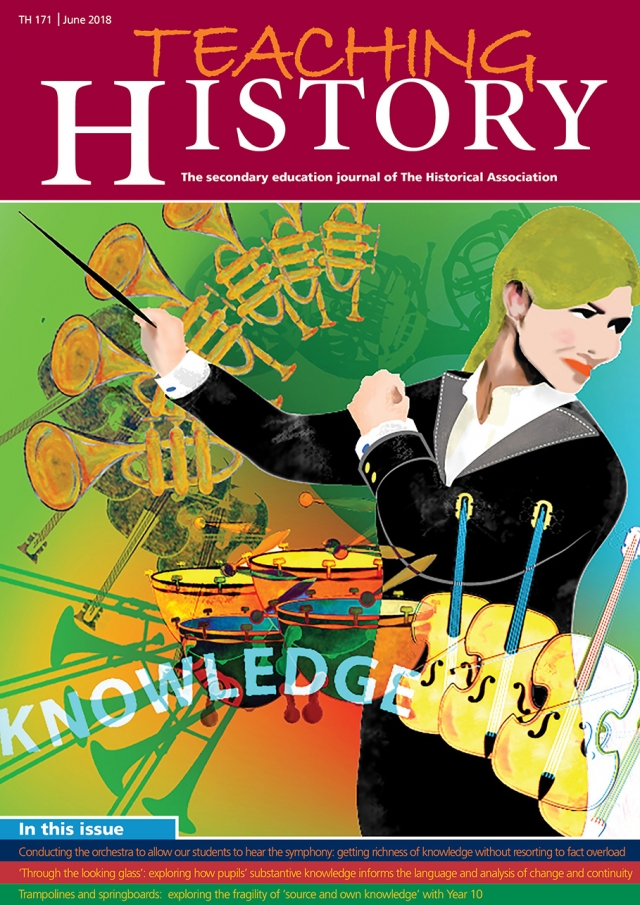Teaching History 171: Out now

Access Teaching History 171 here (Free to HA Secondary members)
Editorial: Knowledge
In recent years, lively debates about the role of knowledge and especially about pedagogies for ensuring its secure acquisition have raged across England’s educational landscape. Much of this has arisen from a new interest, by teachers, in the cognitive science of memory.
A common critical reaction to this new emphasis has often taken the form of ‘…but what knowledge?’ Concerns are invariably voiced about knowledge perpetuating the narrow interests of the powerful, or about certain political narratives being disproportionately emphasised within a knowledge emphasis.
Observing all this from the inside of England’s history education communities, it has been hard to know whether to react with a wry smile or with a wearied sense of déjà vu. For the history education community in England, and in other educational jurisdictions, has had its own knowledge debates, mostly very productively, and for a very, very long time. In particular, the question of ‘what knowledge?’ has been alive and hotly debated since the 1970s with the advent of the Schools History Project and its challenge to the dominance of conventional, high-political, Anglo-centric narratives. It is hard to think of a strong history initial teacher training course since the 1970s that didn’t foster critical awareness of the complex challenge of selecting content from an almost infinite set of possibilities, so as to reflect the diversity and complexity of scholarly history fields. History teachers in the Historical Association have, for decades, discussed ways of innovating around types of content. Some discussion arose in critical challenge to traditions of teaching a certain kind of English (rather than British) history, while some arose from the rise of world history topics at Key Stage 3, first required by the National Curriculum in 1991. This makes generalising about the role of the NC highly complex.
The 1970s also saw a major shift towards the disciplinary dimension of the subject, once called ‘skills’, now often called ‘second-order concepts’. Again, the Schools History Project was central here, but with a new GCSE examination introduced in 1985 and especially the first National Curriculum in 1991, a focus on the provisional character of knowledge, and the need for pupils to understand its construction through evidence, argument and interpretation, swiftly became establishment orthodoxy.
This shift too, although partly motivated by the need to bring school history to many more pupils, brought its own new challenges in achieving that very goal. Many history teachers themselves became analytic, active and vocal, particularly from the 1990s, in claiming that if substantive knowledge were neglected, this hindered some pupils’ progress in critical history itself. Since then, history teachers active in research, in subject associations and in thriving local history education communities, have led the way in the fascinating endeavour of ensuring that substantive and disciplinary dimensions of the subject (earlier known as ‘knowledge and skills’) are not only equally strong, but that they complement and serve one another. This has taken many forms, and has been furthered greatly by publication and other initiatives of the Historical Association.
What is interesting about this tradition in history teachers’ classroom exploration is that it transcends both the longstanding ‘what knowledge?’ debates and the more recent ‘how?’ debates arising from cognitive psychology of memory. History teachers have led the way in what might be termed ‘curricular theorising’, that is, a way of thinking about the incidence, blend and interplay of different types of content, and how these add up to secure particular goals both for pupils’ broad historical knowledge and for their ability to participate in historical argument. It is very common, for example, to read publications by history teachers about the relationship between building substantive knowledge and learning how to shape a causation argument. Likewise, debates about the interplay of secure substantive knowledge and studying sources have been richly explored for at least two decades. They were accelerated by Michael Riley’s challenge, in 2000, to isolated skill-based exercises using tiny gobbets of source extracts, and his case for rooting evidential work in coherent lesson sequences built around secure stories which could be both unified and challenged through a single ‘enquiry question’.
This edition takes forward this rich tradition of practical classroom exploration and debate on how to define and configure historical knowledge. It is an edition alive with fertile metaphor. Alex Ford and Richard Kennett use the metaphor of a symphony to capture the nuance and complexity of building pupils’ historical knowledge in ways that let the textures of knowledge – its melodies, harmonies and multiple instruments – sing vibrantly, rather than becoming cluttered with noise at the expense of the musical journey. Jonathan Sellin explores the vexed issue of getting pupils to connect sources with their own knowledge and concludes that trampolining is a far better activity than the use of a one-way springboard. Barbara Ormond also examines ways of using sources in the classroom. Taking the example of early modern English piety, Ormond shows how a study of images used within ballads benefits from a secure underpinning of knowledge. Both Danielle Donaldson and Alexander Bridges share what they learned about the role of substantive knowledge in shaping pupils’ written argument: Donaldson draws our attention to pupils’ verbs, and Bridges shows how pupils’ use of substantive concepts can reveal crude misconception and oversimplification or a rich backcloth of layers of knowledge.
Reading these pieces, we editors were reminded of Burnham and Brown’s suggestion back in 2004, in Teaching History 115, that progress over time ought to be evident in pupils’ increasingly complex and questioning use of substantive concepts, not the tidy consigning of substantive concepts to particular, fixed definitions. Such are the joys and demands of teaching history – we avoid this complexity at our peril.

